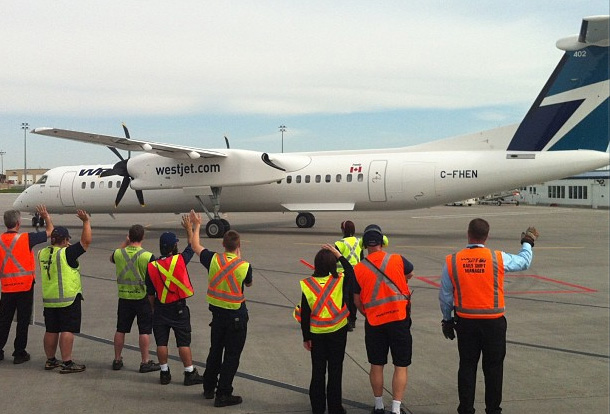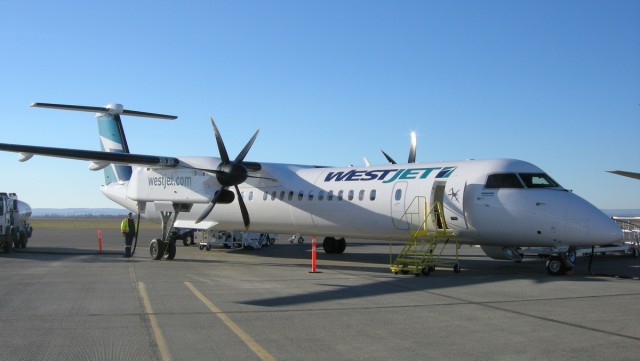
Westjet Encore Bombardier Q400 C-FENY at North Peace Regional Airport (YXJ) in Ft. St. John BC, under a beautiful blue sky. Photo: Howard Slutsken | AirlineReporter.com
This was going to be a great day for AirlineReporter.com’s Canadian “Senior Contributor.” That would be me!
I was flying with a new Canadian airline in a brand new Canadian-built plane, traveling from a major Canadian airport over some stunning Canadian landscape, and visiting the headquarters of one of “Canada’s 10 Most Admired Corporate Cultures,” which happens to be a major Canadian airline. The Flight Attendants might have made it even more Canadian by greeting me at the plane’s door with a Timmy’s “Double-Double” and a hockey stick. That didn’t happen.
Translation? I’m flying with WestJet Encore on a Bombardier Q400 from Vancouver (YVR) over the Canadian Coast Range and Rocky Mountains, and visiting Westjet’s base in Calgary (YYC). I’ll leave it to you to find out about Timmy’s.
WestJet Encore began flying in late June with two 78-seat Bombardier Q400 NextGen turboprops. Since then, five of their initial order of 20 Q400s have been delivered, and they have options on another 25 planes. WestJet Encore augments WestJet’s Boeing 737-based route structure with regional flights of distances up to 700 miles. That’s about a two hour flight time for the Q400, but most destinations are 60 to 90 minutes apart. Having the Q400 in the fleet will give WestJet the flexibility to fly to new destinations, add additional frequencies to current destinations, or “right size” the service throughout their network by swapping 737s with Q400s. The Q400s are pretty quick, with flight times within 10-20 minutes of a 737 over these short distances.
The first destinations included Nanaimo, BC in the west, and as far east as Saskatoon, SK. As more planes come into the fleet, Encore is adding destinations and continuing their expansion eastwards. Encore brought WestJet service back to Brandon, MB in September, a destination that previously couldn’t support WS 737 service. This YYC-YBR flight is currently Encore’s longest, at a bit under 2 hours. In addition to adding direct regional flights to the WestJet schedule, Encore will look to keep travellers “in the family” by providing connections to mainline WS flights, and those operated by codeshare partners. Encore is also part of the “WestJet Rewards” frequent-flier program, and shares facilities with WS at common destinations.
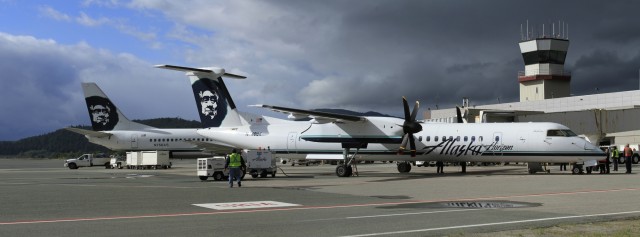
Alaska Airlines Bombardier Q400 on proving flight in Juneau, Alaska – Photo: AirlineReporter.com
Alaska Airlines (AS), through their wholly-owned subsidiary Horizon Air, recently announced that they would deploy some of their Bombardier Dash-8 Q400 aircraft to the State of Alaska. While Dash-8’s have long been a fixture in Alaska Airlines’ pacific northwest network via Horizon (I was flying them within Washington as a child), this marks their first major deployment up north.
Why would AS begin flying Q400s in Alaska? For the same reasons other carriers have moved towards regional jets and turbo props – operating costs, frequency, and flexibility. On the operating cost side, Q400s are extremely efficient, particularly compared to the Boeing 737-400s that are a mainstay of the AS fleet in Alaska. Bombardier estimates savings in examples like this to approach 40%. From a frequency and flexibility standpoint, more flights on a smaller plane can meet passenger demands, maximizing load factor while increasing service frequency, to the benefit of passengers.
This morning at 11:28 AM (Mountain Time), Westjet Encore‘s first passenger flight left Calgary, Alberta (YYC) for Nanaimo, BC (YCD). The flight was operated by one of the two 78-seat Bombardier Q400s that Westjet Encore has received from their initial order of 20 planes. The other initial destinations for this soon-to-be-growing regional airline are Fort St. John, Victoria and Vancouver, BC, and Saskatoon, Saskatchewan. Brandon, Manitoba will be added in early September. They’ll continue to grow as another 5 Q400s come into the fleet before year-end.
It’s clear that Westjet has positioned their new airline to try and break the monopoly that Air Canada Express (Jazz Aviation/Chorus Aviation) has enjoyed over the years in many smaller Canadian communities. In fact, Ferio Puglieses, the new airline’s President, is pretty blunt about their objectives: “WestJet Encore is here to liberate smaller communities from the high cost of regional air travel while continuing to provide every guest with our award winning culture of care.”
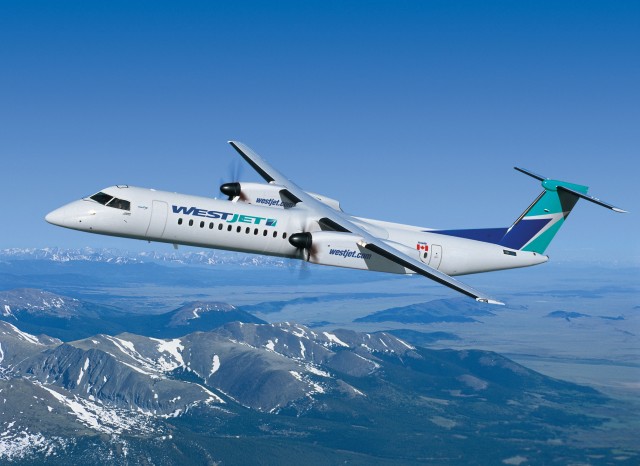
What WestJet’s new Bombarider Q400 will look like. Image from Bombardier.
WestJet has announced their plan to start a regional airline using Bombardier Q400s. This is by no means breaking news, but a story that somehow I missed and have been playing catch up and wanted to share some of the things that I have learned.
For those of you who might not be aware of WestJet, they are a low cost carrier, based at Calgary International Airport (YYC) in Alberta, Canada. Previously, they only operated a fleet of Boeing 737 aircraft in an all-economy layout.
In January of this year, WestJet stated that they were looking into starting up a smaller subset of their almost 100 fleet of 737s. At the time, WestJet President and CEO, Gregg Saretsky, stated, “A short-haul aircraft combined with WestJet’s brand, balance sheet strength and low-cost structure will allow WestJet to profitably accomplish four main goals: Introduce WestJet’s friendly and caring service to many smaller communities who have asked for our service; optimize the size of aircraft to efficiently increase frequency; create new connections between existing WestJet markets; and build additional feed to our current 71-city network so that we can continue to profitably grow and add shareholder value.”
The airline’s management talked with employees and in February, the airline announced that 91% of employees voted in favor to launch the regional airline. I would imagine that WestJet employees do not have a union is one reason the high number.
Then, the fun part came; which aircraft to buy? Although the photos of the Bombardier Q400 in WestJet livery on this story gives away the answer, they were also considering the ATR 72-600.
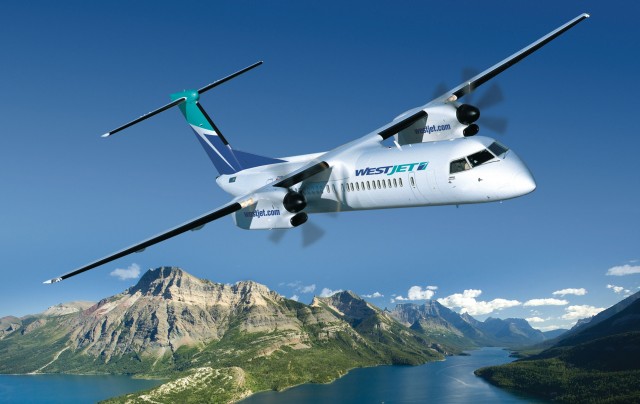
What WestJet’s new Bombarider Q400 will look like. Image from Bombardier.
“We are very impressed with the Q400,” Saretsky stated in a press release. “Both ATR and Bombardier put forward excellent proposals and ultimately we believe the Bombardier Q400’s combination of range, speed and seat density is the best choice to meet the needs of the market and how we plan to operate the regional airline.”
WestJet signed a letter of intent to purchase 20 Q400s with the option to purchase an additional 25 aircraft. The airline hopes to start regional service in 2013.
I was curious how the new Q400s would operate in the WestJet fleet and would there be a different customer service product on the Q400?
“The two airlines will operate under separate certificates. However, they will both be WestJet in every respect — culture, guest experience and even livery,” Robert Palmer, spokesperson for WestJet explained to AirlineReporter.com.
The Q400s will be used on flights lasting about one to two hours and the 737s will fly on longer routes. Both airlines will cover domestic and trans-boarder flying and the Q400s will act as a feeder system for the mainline 737s. Palmer also stated that the Q400s might be placed on current routes that have less demand and free up a 737 for additional service.
On top of starting regional service, WestJet has also stated that they will start offering premium economy seating. Each aircraft will have four rows of seats with 36″ of seat pitch and the addition of priority boarding and complimentary on-board amenities.
With Southwest Airlines flying to larger airports and bringing on the 737-800, Allegiant going from one aircraft type to three and WestJet adding regional service and premium seating, it is anyone’s guess what these low cost carriers will do next.
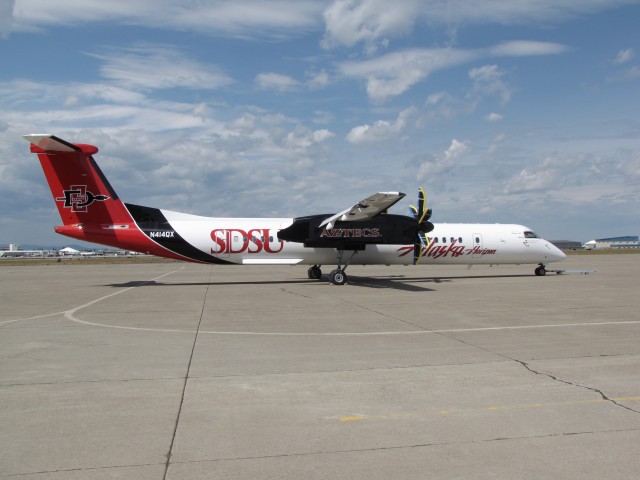
The newest livery on Horizon's Q400 is one for the San Diego State University Aztecs. Image from John David Wicker.
Horizon Air, which operates Capacity Purchase Agreement flights for sister carrier Alaska Airlines, is the eighth largest regional airline and is based in Seattle, WA. Recently, their own Horizon livery disappeared and was replaced by Alaska’s Eskimo, but the airline still retained a nice collection of unique liveries.
On May 31st, Alaska showed off their newest livery: San Diego State University at San Diego International Airport (SAN). The unveiling of the new livery was timed to celebrate the start of Alaska Airlines new San Diego flights to Fresno, Monterey and Santa Rosa, Calif., which began on June 4 and 5.
’œWe’re proud to add San Diego State University’s bold colors to our fleet of university planes and especially pleased that this aircraft represents our first California school,’ said Joe Sprague, Alaska Airlines’ vice president of marketing. ’œWe hope the Aztec plane will bring smiles to our passengers and be a source of pride for SDSU students, alumni and faculty for years to come as we fly it throughout our regional route network.’
It took a crew of eight people working around the clock for seven days at Associated Painters, located in Spokane, WA to paint the SDSU livery. The painting required 32 gallons of white paint, 10 gallons of red paint and four gallons of black paint. In addition, about 2,000 sheets of sandpaper and 10,000 yards of masking tape were also used.
Check out the gallery below for additional special Horizon/Alaska Q400 liveries:
[nggallery id=4]


